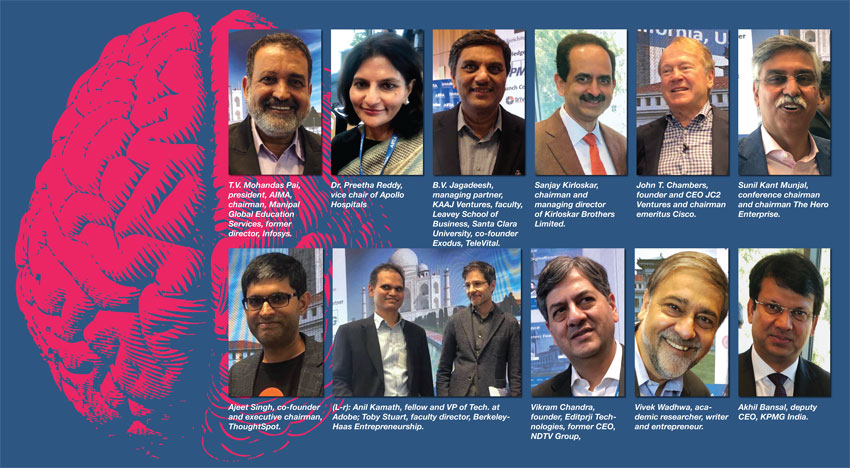Dissecting the Indian Brain Bank: AIMA’S 3rd U.S.-India Conference
Having grown up attending conferences in Bangalore and as Sacramento offers such activities few and far between I ventured to the SF Bay Area readily, to attend the 3rd U.S.-India Conference, writes Dr. Firdos Sheikh.
I have been excited about the prospects of a digital India. I have been concerned about the brain drain and the fact that we are being sucked into a “service” requiring consumer market. I was concerned that Innovation and inherent entrepreneurship was being over stepped in lieu of the demand for service alone. That skills were being used and not engaged in creative building. What I learnt at this conference reassured me immensely about the future and vision for a constructive and creative platform.
The topics instantly captured my interest. It seemed like a platform laying the foundation for corporate innovators, and I was right!
What better venue than the Haas School of Business at the University of California, Berkeley. A world leader in producing the world’s best, both in leading producers of new ideas and knowledge in all areas of business, and a University that has produced two Nobel Prize winning faculty.
Haas has a strong alumnus of 40,000, and cater to 2,200 students per year, aspiring to learn from the very best. The panel of speakers were brilliant and exciting. The topics were diverse and yet encompassing of the agenda in hand.
What caught my interest was T.V. Mohandas Pai, president of AIMA, chairman of Manipal Global Education Services, and former director of Infosys India.
As an alumni of Pai Dynasty education ventures via the medical school I attended – Kasturba Medical College – and knowing the excellence it offered, I was convinced that this was a ‘must attend’ venture, that would offer well thought out topics.
John T. Chambers, founder and CEO JC2 Ventures and chairman emeritus Cisco, and Sunil Kant Munjal, conference chairman and chairman The Hero Enterprise were on the panel of Digital India: An El Dorado for Start-up Investors.
John spoke enthusiastically about the promise India holds and the myriad of possibilities. He believed that the right mix of intelligence, market, innovation and entrepreneurial possibilities was unstoppable in navigating the success of India.
Sunil Munjal, one of the earliest of entrepreneurs, agreed with equal zeal. He is known as the institution builder in India’s premier automotive manufacturing group that has evolved from being the world’s largest bicycle maker to the largest two-wheeler maker in India.
Envisioning India’s Digital Economy
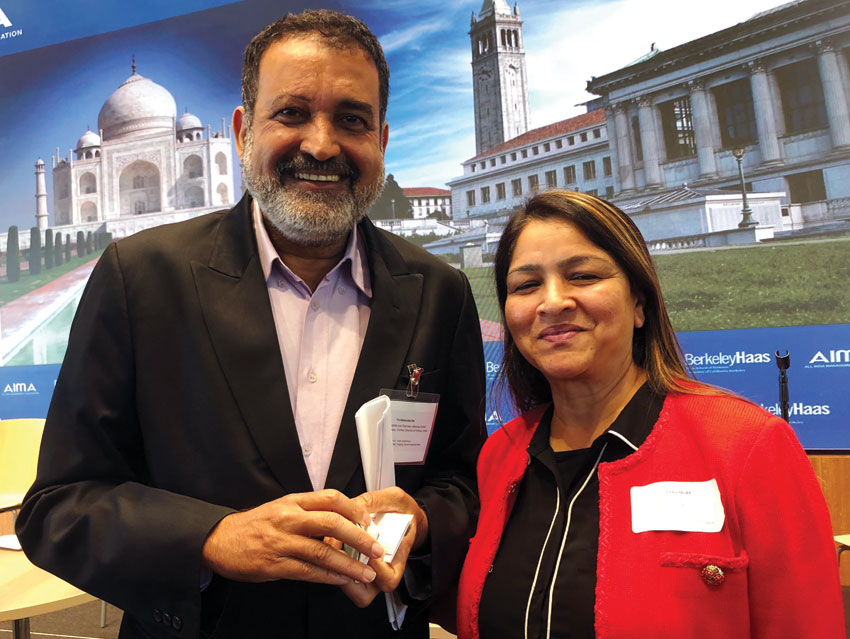
Speakers: Vikram Chandra, former CEO of NDTV Group, founder Editprji Technologies, a startup that seeks to transform the news space through innovation in user experience, using artificial intelligence; T.V. Mohandas Pai, president AIMA, chairman Manipal Global Education Services and former director of Infosys India; Vivek Wadhwa, academic researcher, writer and entrepreneur, columnist for The Washignton Post, fellow at Harvard Law, Carnegie Mellon, has held appointments in Duke, Stanford, Emory, and is based in Silicon Valley; and Akhil Bansal, deputy CEO of KPMG in India.
They introduced us to the staggering possibilities of what digital India could look like and what the startups are headed for.
There are half a billion internet users and by 2025 that number is expected to double. The goal is to take the country’s digital economy from $400 billion to $1 trillion in the next 6-7 years and to $5 trillion by 2030.
Given the population and potential users it was wonderful to learn about the targeted markets.
The biggest American and Chinese digital companies are vying for a piece of this growth.
It was fascinating how digitalization had already planted its roots into many sectors of the consumers including manufacturing, agriculture, healthcare, education, entertainment, travel, banking, and so on.
As I understand, the foundation and seed has been planted. What now needs to be worked on is the bureaucratic hurdles and infrastructure which is the restrictive factor presently. Having identified the culprit to me was innovative in itself. It’s like a wagon that is ready and taking off, but the tracks and path have not been prepared enough to carry the burden of such explosive growth and speed. That should not be a difficult sector to smoothen out is the hope. Paving the terrain is imperative when the users of such terrain will lead to immense success.
Vivek and Mohandas were eloquent, their thoughts and concepts transcended you to a world full of promise. They were true visionaries, optimistic for the perceived potential in Indo American growth prospects.
I had the opportunity to meet Mohindas Pai. He has an excellent global vision of where India stands today in the world of technology and education. He enlightened us with his vision of innovation and growth being at the brink of evolution in a very concise way.
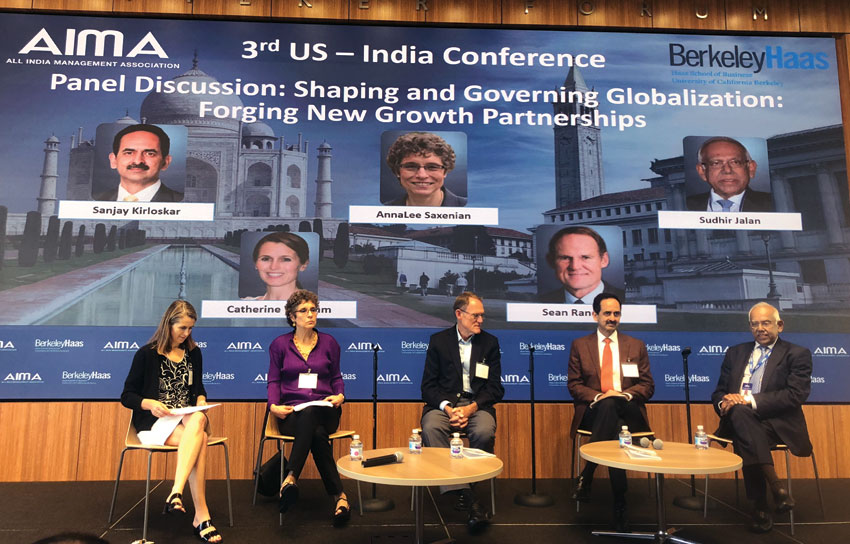
The Take Home Message
- Growth is visibly happening.
- Phenomenal opportunities for startups is a promise.
- Regulatory regimes have to be implemented as soon as possible to prevent a restriction of growth, and bureaucratic rhetoric needs to be geared towards facilitation and not obstructive.
- In a nutshell, in both numbers, market, growth potential and expertise, India is in a position to say – You need us more than we need you.
However, it remains to be seen who bells the cat and who and how the cats walk the ramp.
There were discussions on trade war between U.S. and China, China and India, and U.S. and India. AnnaLee Saxenian, Dean of School of Information UC Berkeley; Catherine Wolfram, acting associate Dean for Academic Affairs Berkeley Haas; Sean Randolph, senior director Bay Area Council Economic Institute, were among those who felt a trade war was imperative. They also discussed how the Silicon Valley by far has the best IT and business leaders globally.
Sanjay Kirloskar, chairman and managing director of Kirloskar Brothers Limited, answered that aspect of concern in a very calm and controlled manner. He alluded to the fact that each has an ulterior motive, so trade war cannot happen.
He reminded us that the British taught us English so that they can communicate but Indians learnt English as they saw growth and have used it well.
The railways were implemented by the British so that they could take out the resources from India, but not realizing that it also indirectly opened up learning avenues for the Indians. Again, they learnt trade and globalization well. When the tracks are laid out, building self-designed carriages and personalizing it is no rocket science.
Similarly, English was taught to make it convenient for the British but by default Indians learnt it and it facilitated their growth. Likewise, trade war and the fear of its occurrence is a moot point as one country’s loss will become another’s gain. These are the masters in Indian business world who have walked the talk and have emerged victorious.
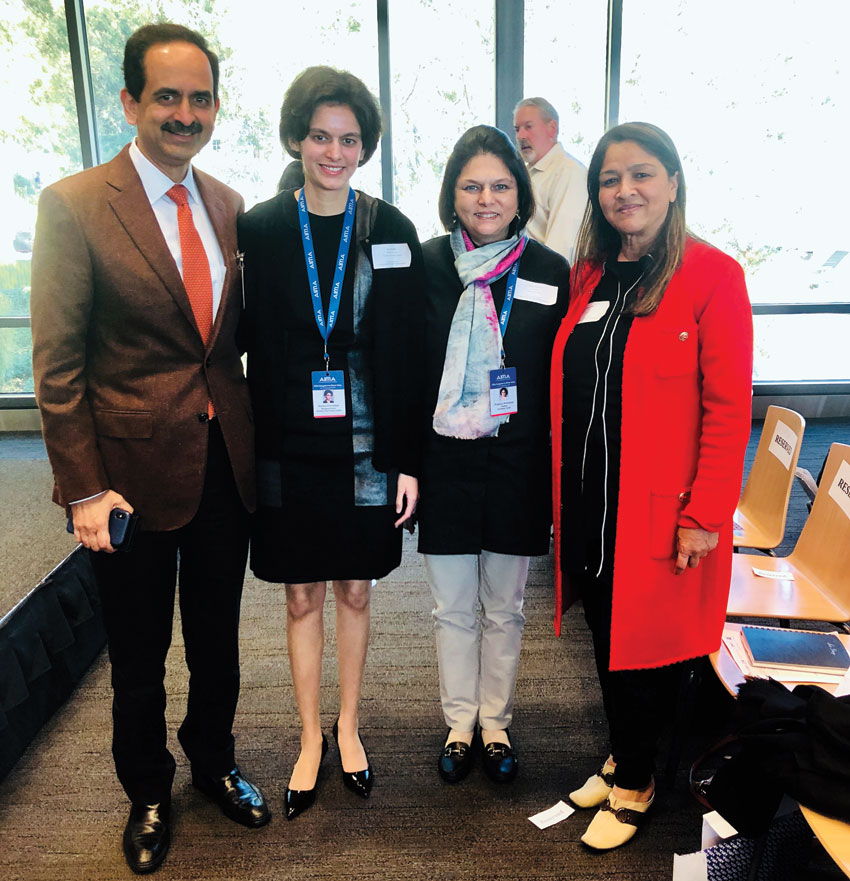
The most important of these discussions for me was the Healthcare sector.
Dr. Preetha Reddy, vice chair of Apollo Hospitals, Asia’s largest healthcare provider, focused on how to bring in high quality healthcare and make it accessible to millions across the country. It was exciting to see how digital medicine was in the works and the vision was to bring healthcare to the fingertips. Speed and accuracy of accessing healthcare was on the agenda as well.
In her talk, she educated us about how the growth of this healthcare industry is falling short because of shortage of skilled workers.
I did discuss with her that the service needs and what is being offered outside of India is one of the major setbacks for the brain drain in this sector as well. We talked about the possibility of starting an alliance wherein doctors and healthcare professionals from here could start a program to help fulfill, at least partially, the need for skilled staff and narrow the gap.
It seemed that the infrastructure was already in place and we just need to join forces to fill the slots that needed the skilled staffing and facilitate implementation. This would help in reaching many more healthcare challenged population in India. A service that, I have no doubt, will be gladly embraced as it’s a form of giving back to the community and country.
Again, the digitization of healthcare held phenomenal promise.
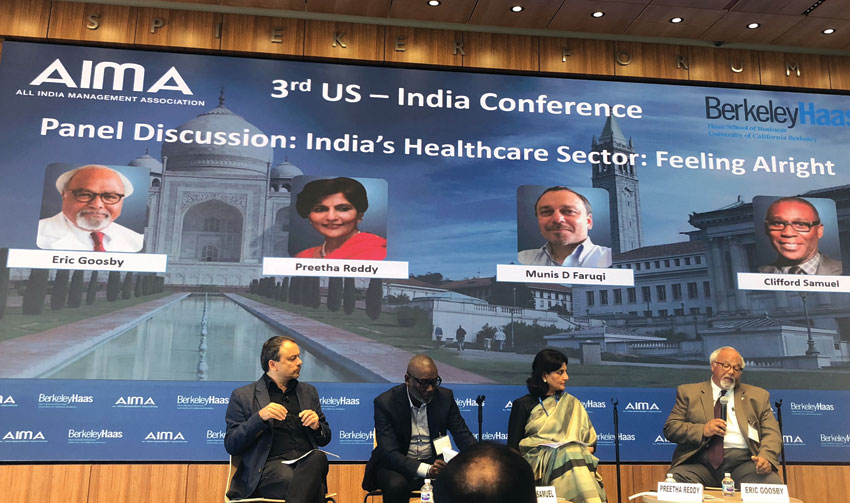
It was wonderful to hear the detailed insight and challenges as well as a global perspective about the happening healthcare changes. The accomplishments, the future plans and the exciting possibilities that digitalized medicine brings, and what that would mean to healthcare in India.
How amazingly millions of people are going to become a part of very inexpensive and effective healthcare. Women of India are truly the leaders and the nurturers as we can clearly see in Preetha.
There were many more spectacular speakers, but I was looking to meet the IT and venture capitalist leaders of Silicon Valley and check out their perspective.
Amongst them was a well-respected figure in Silicon Valley, B.V. Jagadeesh, managing partner, KAAJ Ventures. What excites this angel investor most?
The idea of India as an IT superpower. “We have earned much respect in the Valley – now it’s time to recreate that as an India brand,” says B.V. Jagadeesh.
As member of TiE, Jagadeesh has, in the past month, sold dreams of entrepreneurial glory to aspiring Indians. He is more interested in deriving value from his other role as angel investor to Indian entrepreneurs. He is firmly established as a serious investor – but only in start-ups that are not in it for the valuations alone. Jagadeesh believes that technology and services that last for the long term are the only ones, worth looking at.
He has a word of advice for start-ups: “Don’t start a company to sell out in a year, VCs are not dumb to fund ideas of that sort.” Currently he feels unless the bureaucracy is relaxed, and fundamental elements needed to ensure a smooth transition of investment are provided, he would be more inclined to investing in China.
Other notable IT champions included Anil Kamath, fellow and VP of Tech. at Adobe, a primary architect of Efficient Frontier, leader in Shopzilla and an IIT Bombay and Stanford graduate; Ajeet Singh, co-founder and executive chairman at ThoughtSpot, he is of Nutanix fame, and has worked in Oracle and Aster Data prior to Nutanix. He topped his class in IIT Kanpur. These technologists have created billion-dollar technology companies from scratch and are the cream of the crop and a sample of the Indian Brain Banks.
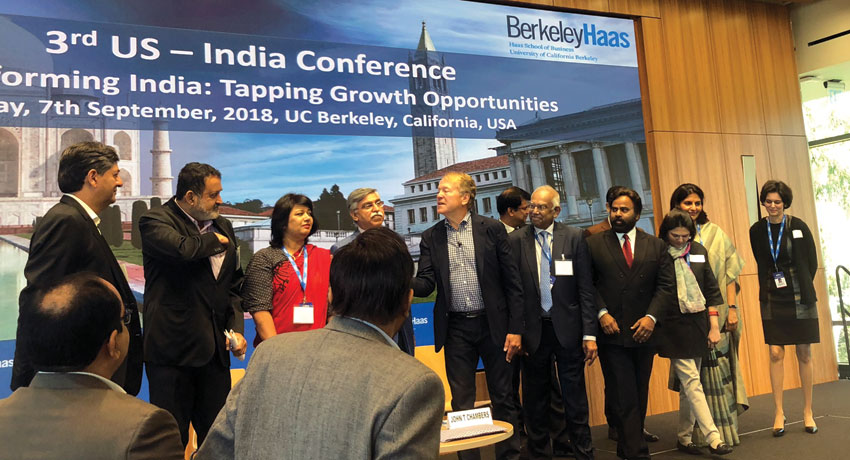
They started with make believe offices in Starbucks as they could not afford offices. It’s all success stories. They were not investors but felt India needed to build a better path of growth to facilitate confident funding and entrusting entrepreneurial ventures effectively.
With most of the happening tech tycoons from India and Silicon Valley at this meeting, it turned out to be a ‘Great Brain Talk’ and I loved what they had to say and their vision. I left with a promise for a better world. It was as if we were going a full circle.
India strives to excel in their education. Their product, today, is ready to give back in a big way. It was a beautiful reunion of sorts. Akin to a parent who smiles at their children and akin to a child who looks at the parent ready to close the generation gap and unite forces.
Let’s pause the service driven robots. Start by changing the DNA of our industries, as today we are trapped in a “service mode” mutation.
With an exploding national market, an abundance of tech talent, there is a need to take this plunge and create a link of the faculties.
It’s time for the Brain Bank to innovate, and to venture and invest, instead of burning ourselves as service stations and pushing our entrepreneurial creativity to the back burner.
Our excellence is disharmonious and disjointed. Academia is spiraling within an outdated curriculum. Industry demands for escalated skills. Dots between academia and industry demands need to connect. The cloud needs to intervene with speed. We can evolve into a harmonious digitalized ecosystem. India holds that promise.
Hope a neurologist’s perspective of a techy world could connect the dots and spark (digitize) the energized aura. Thank you, Rekha Sethi, director, AIMA, for this spectacular conference.
